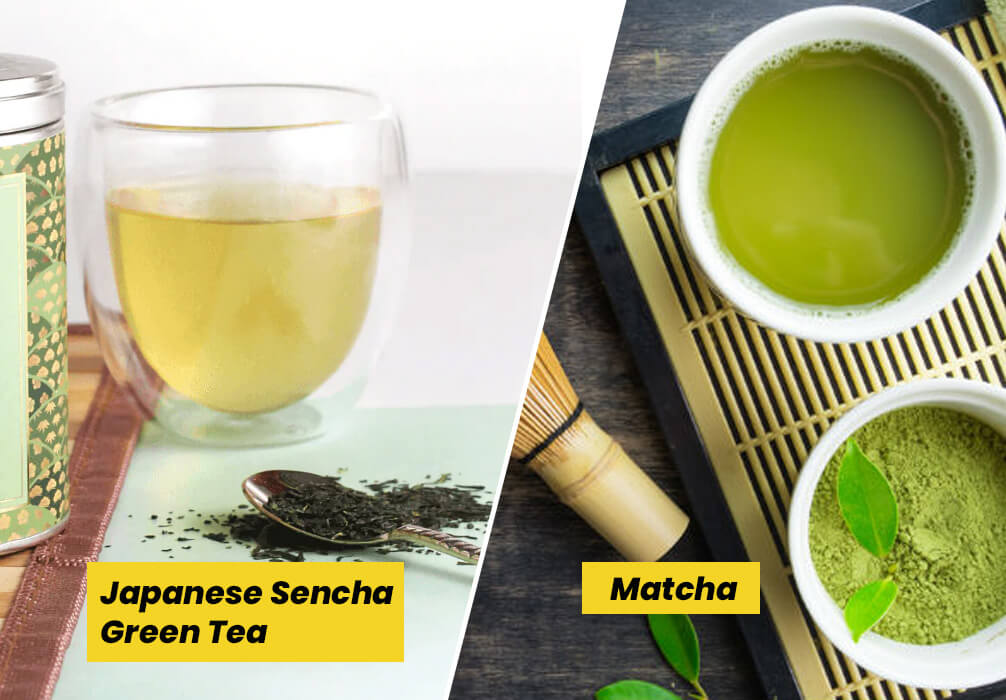Comparing Japanese Sencha Green Tea and Matcha: An Analysis of the Differences
Japanese green tea holds a special place in the hearts and traditions of Japan, with Sencha and Matcha being two beloved varieties. Even though they share the same ingredient called Camellia sinensis plant, they are grown and processed differently. Apparently, both forms of green tea have distinct tastes, textures, and brewing methods. Let’s explore the distinctions between Sencha and Matcha to learn about their unique qualities and how they might improve your tea experience.
Understanding Sencha and Matcha
Japanese green teas, Sencha and Matcha, both have unique qualities and cultural significance. Sencha is a steaming green tea that is noted for its fresh, grassy flavor, whereas Matcha is a powdered green tea that is prized for its rich umami flavor and vivid color. Despite both originating from the same Camellia sinensis plant, the processing methods and brewing techniques set them apart, creating unique drinking experiences for tea enthusiasts.
Differences Between Sencha and Matcha
- Growing Method
Sencha and Matcha are primarily distinguished by the ways they are grown. Sencha is grown in direct sunlight, which encourages the leaves to produce a vibrant green color and a grassy and refreshing flavor. Matcha, on the other hand, is grown in shaded conditions for several weeks before harvesting, which increases chlorophyll production and gives the leaves a rich and deep green color and a sweeter, more umami flavor.
- Harvesting Method
Sencha leaves are harvested by hand or machine in the spring, with only the top leaves and buds being plucked. Matcha leaves are also harvested in the spring, but only the youngest and most tender leaves are selected for grinding into powder.
- Processing Method
Sencha leaves are steamed immediately after harvesting to prevent oxidation, then rolled and dried. This process maintains the leaves’ vivid green color and crisp flavor. Matcha leaves undergo a unique process where they are steamed, dried, and then ground into a fine powder using traditional stone mills. This produces a concentrated, vivid green tea with a deep, umami flavor.
- Brewing Method
There are also notable differences in the brewing techniques of Sencha and Matcha. To bring out the subtle flavors of Sencha, it is usually steeped for one to two minutes in hot water (80 to 90°C). The tea leaves are to be discarded afterward. In contrast, Matcha is made by whisking hot water(70 to 80°C). and powder together until frothy, resulting in a rich and creamy drink. When drinking Matcha, the whole tea leaf is ingested, thus offering a more concentrated and powerful dose of antioxidants and nutrients than sencha.
- Flavor Profile
Sencha is prized for its crisp, grassy flavor that ends with a hint of astringency and vegetal overtones. Its flavor is energizing and refreshing, making it ideal for regular usage. Conversely, Matcha has a smooth, velvety texture, creamy undertones, and a pronounced umami flavor. Compared to Sencha, it has a more potent and concentrated flavor profile, which makes it a special and decadent delight.
Kyoto Beverages: Provide the Premium Quality Japanese Green Tea
We, at Kyoto Beverages, take great satisfaction in providing Sencha and Matcha varieties of Japanese green tea that are of the highest caliber. Our teas are carefully processed to guarantee outstanding flavor and freshness, and they are sourced from the best tea estates in Uji, Japan. You can count on Kyoto Beverages to provide you with the best Japanese green tea, whether you like the rich, decadent flavor of matcha or the refreshing taste of sencha. Sencha and Matcha Green Tea have similar origins, but they have different tastes, preparation techniques, and applications. Sencha and Matcha offer distinctive experiences that honor the rich history of Japanese green tea, whether you’re looking for a cool drink or an adaptable component. Discover the subtle differences between Sencha and Matcha to find your favorite tea, then enhance your tea-drinking experience with Kyoto Beverages’ superior selection.




































